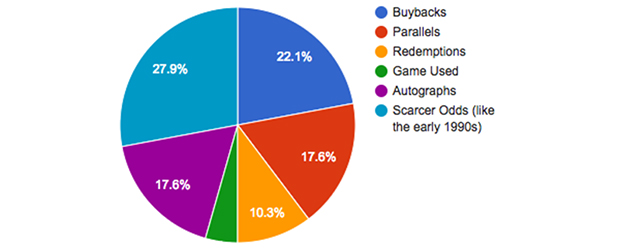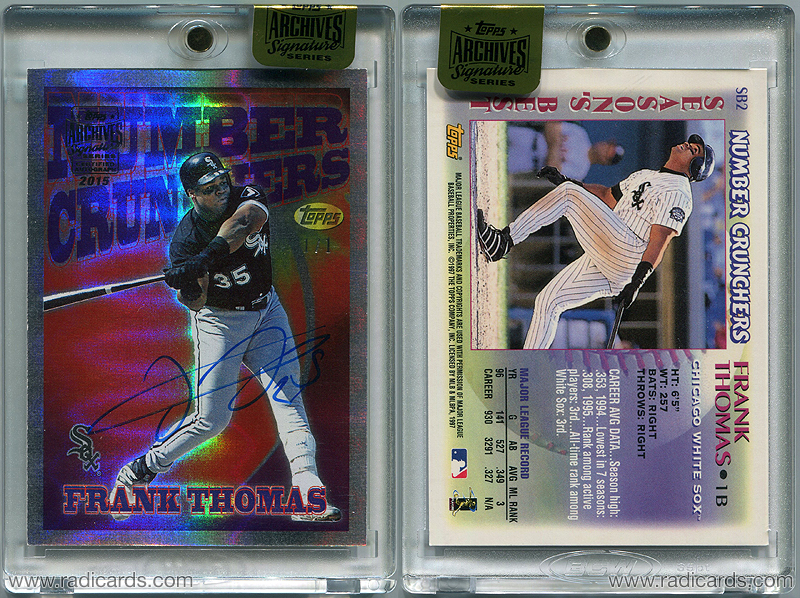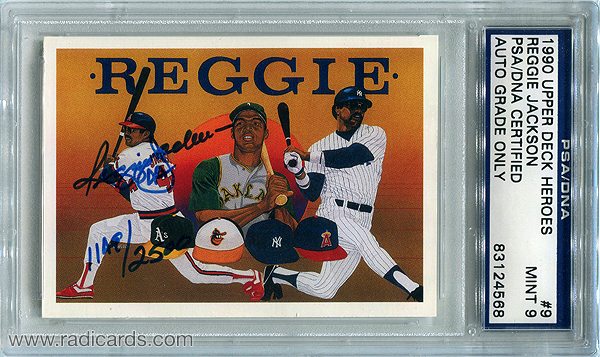
I conducted a brief temperature check of the hobby market with a one question survey asking the respondents to select one of a series of choices. I wanted to see what people think will be the main trend for 2016. The options are listed in the interactive pie chart. There was a 7th option for “Other” but due to 11 unqualified responses, we’re going to leave those off. I received 79 responses less the 11 Other responses for a total of 68 qualified survey responses. With this number, we can statistically generalize our results.
As we can see from the results, there are two dominant predictions: Buybacks, and Scarcer Odds. Let’s talk about each.
Buybacks:
I’m not at all surprised that Buybacks made a significant presence in the results data. Since 2015, Topps has enjoyed a lackadaisical focus on scrutiny, and more importantly innovation when it comes to Buybacks. Not only do we see a massive surge of junk wax era base cards posing as Buybacks but we also see misinformation stated on the backs of cards like the 2016 Topps Berger’s Best AU Relics card of Robin Yount. The back of this card mentions ’74 Topps Mini being Yount’s Rookie Card, which happens to be two pieces of false information wrapped up into one statement:
- 1974 Topps Mini doesn’t exist
- Robin Yount’s Rookie Card is in 1975 Topps
Gee… thanks, Topps.
The prediction of Buybacks being more prevalent in 2016 is less of an assumption and more of a fact. Topps has entertained the Buyback campaign many times in years past but in 2015, it officially took the 1/1 concept out back and shot it right in the head. For many collectors, it’s a love/hate relationship with products like 2015 Topps Archive Signatures Series, and 2016 Topps Buybacks
. Essentially, what we have here is a collection of common to extremely common base cards from past decades signed and/or stamped as 1/1s. With many of these cards fetching upwards of 3-4 figures, this can get really ugly for player collectors. Like choice, saturation is demotivating.

I love the Buyback concept because I think it’s a great way to re-enjoy some of the old stuff. I think this concept, in and of itself, is good for the hobby. But like alcohol, excess can be crippling. I like Buybacks, but do I really need to track down 35+ signed examples of them for my guy from just one single product? It’s overkill. I have to accept that unless I’m willing to shell out thousands, I’m completely out of luck. Now, I know this is basically an adult hobby nowadays due to cost but geez man, at least make it somewhat feasible just to participate! Is it too much to ask to attract kids back to the hobby since they are, in fact, the future? Most kids probably don’t have $100 to spend on a single pack of cards.
In 1997, the term “Master Collection” became a moot point. We can credit this decline to the release of the prestigious 1997 Flair Showcase Masterpiece, which was the first pack-inserted 1/1 to ever enter the market. I absolutely love this set. So I cannot acquire a master collection anymore, so what. I can now enjoy the possibility of owning something nobody else has. That, to me, is extraordinary; I can appreciate that.
Like anything, it loses significance with repeated encounters. Since 1997, the 1/1 has lost some of its luster. This is, in a large way, due to the various Buyback campaigns that have entered the market over the years. Topps, like any business, carefully considers the bottom line with any decision. I get that, and I respect it. I do. Where it falls short is when the products lack innovation and further contain erroneous information. I struggle with that and even more with Topps because of its illustrious seniority. I guess I just expect more from the proprietors of both MLB and MLBPA licenses. But what else is there? What could Topps do that hasn’t yet been done, or beaten completely into oblivion?
To better reduce anxiety and help invite kids back into the hobby, I would suggest the release of single non-signed Buybacks that are stamped but aren’t serial numbered and inserted at frequencies of phenomenal rarity like it was in the ’90’s. This would make it fun without indiscriminately forcing participants out of the market.
Scarcer Odds (like the early ’90’s):

This was the majority vote and can be coupled with any of the other categories. Again, I like this category. Scarcer odds means stronger integrity with hits. I believe that rare cards should exclusively feature proven powerhouse talent. This would ensure that any significant pull is guaranteed to feature a great player, not some random scrub that hasn’t and possibly never will see the big leagues. Not only would this be more exciting, it would help boost morale. Nobody wants zero ROI on what manufacturers claim to be “case hits.”
Is there any excitement in a guarantee? I mean, really. I don’t know how fun life would be if I was guaranteed this or that. The romance associated with living can be partially credited to uncertainty. Just to think that anything could happen can be a big draw, especially for the adventurist and particularly for the hobbyist. I can remember back when 1991 Donruss came out and everyone was opening box upon box in search of cards from the still ultra elusive 1991 Donruss Elite series. I opened so much of this stuff and never once did I pull an Elite. To my knowledge, the odds for these cards were never published and this made me as excited as a fat kid in a candy store.
Uncertainty can be attractive. Attraction can drive sales. Sales can keep companies in business. Business can drive the economy. Conclusion: Uncertainty is good for the economy. Don’t guarantee me anything when I buy sealed wax; it doesn’t excite me and it hurts the economy.
Let’s bring back the ultra scarce insert set that exclusively features Hall of Fame worthy talent. Let’s do it without the autographs and materials. Let’s do it like we did in the early ’90’s where a big hit really was a big hit. I’m excited just thinking about this hopeful future and I know I’m not alone.
To see the current eBay auctions for the 1990 Upper Deck Reggie Jackson AU, click here.

 Have you visited our store? Click here.
Have you visited our store? Click here.


